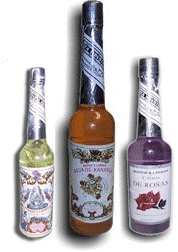The plant spirits in the Amazon love strong, sharp, sweet smells. Thus, one way to acquire protection against malevolent persons and their pathogenic projectiles is to acquire such a sweet smell oneself, as opposed to the ordinary human smell, including the smell of human sex, which the spirits dislike. Shamans achieve this state, and provide it for their patients, by putting substances with sharp sweet smells either on or inside the body.
First among such substances is, of course, tobacco, which is ingested by indigenous shamans in every conceivable way, and by mestizo shamans primarily by smoking or by drinking cold infusions of tobacco leaves in water. Blowing tobacco smoke onto the body of a patient, or into the body by blowing the smoke into the top of the head, is part of the foundational triad of mestizo shamanic healing — shacapar, rattling; chupar, sucking; and soplar, blowing.
 |
| Agua de Florida, Agua de Kananga, and Colona de Rosas |
For the same reason, mestizo shamans ingest commercial cologne, mouthwash, disinfectant, and camphor. Two commercial products are particularly common — Timolina, marketed in English-speaking countries as Thymoline, a commercial alkaline mouthwash and gargle containing thyme oil, eucalyptol, menthol, and pine oil, dissolved in alcohol, similar to Listerine; and Creolina, marketed also as Creoline, Creolin, Cresyline, and similar names, a disinfectant made of cresol or cresylic acid in soft soap solution, similar to Lysol. Shamans also drink camphor dissolved in alcohol, and a drink called camalonga — a mixture of camphor, alcohol, white onion, and the seeds of the camalonga plant, yellow oleander (Thevetia peruviana).
And shamans drink perfume, primarily the cologne called Agua de Florida. There can be combinations of sweet substances: Pablo Amaringo tells of one female shaman who drank a mixture of chopped tobacco, perfume, camphor, aguardiente, hot pepper, lemon, and salt, together with a little arsenic. “Then she drank everything,” Amaringo says. “Large black stains appeared all over her skin.” The shaman began to sing and sing, and to blow forcefully here and there with her perfumed breath. My own teacher doña María Tuesta drank a mixture of tobacco, camphor, camalonga seeds, and Agua de Florida cologne.
Shamans often place perfumes and colognes on the bodies of patients, as crosses on their forehead, chest, and back, whistling a special song of protection, to seal, close, and protect the body. Some blow aguardiente over a patient’s body, as a fine fast spray from their mouths, to cleanse and cure, or the mouthwash Timolina, or the disinfectant Creolina. There is a type of shaman in the Amazon called a perfumero, who specializes in the use of such scents to attack, to heal, and to attract.
Agua de Florida was first manufactured for Victorian ladies in the nineteenth century by the firm of Murray and Lanman in New York. It is remarkable that this commercial cologne should have assumed such a central role not only in the shamanism of the Peruvian Amazon, but also for magical purposes among people of African-diaspora descent in the United States and the Caribbean: bottles of Agua de Florida can be found equally on the mesas of Amazonian healers and on the altars of Vodou priestesses in Brooklyn. Other colognes — Agua de Kananga, Colonia de Rosas — are also widely used, and may be found for sale in the herbal market in Belén in Iquitos.
Another way of acquiring a protective sweet strong smell is by taking a limpia or baño de flores, cleansing flower bath, using strongly scented herbs, flowers, and commercially prepared perfumes. The fragrant plants used in limpias include ajo sacha, wild garlic (Mansoa alliacea); albaca, wild basil (Ocimum micranthum); ruda, rue (Ruta graveolens); mishquipanga, dwarf ginger (Renealmia alpina); and mucura, garlic weed (Petivera alliacea), as well as other plants — especially those that are morado, purple — which protect from sorcery. To these may be added commercially prepared perfumes and floral essences — Agua de Florida, Agua de Rosas, Agua de Kananga, Rosa de Castilla — and the thyme-scented mouthwash Timolina. These baths are wonderful.
Agua de Florida is a teacher, just like the plantas maestras, the plants who teach, and one can undertake la dieta, a restricted diet, with Agua de Florida just as one could with any healing or protecting plant. For thirty days, says doña María, drink a small bottle of the cologne every night before going to sleep, then sit quietly during the day, concentrating and smoking mapacho cigarettes. At the end of this time, the genio, the spirit, of Agua de Florida will come to you; he will appear in a dream or vision, she says, as an hombre buen gringo, a very European-looking man. He will have three birds with him and the spirits of four spiny palms — birds that serve sorcerers, and the thorny palms from which sorcerers make their virotes, magic darts. The spirit of Agua de Florida will ask you, “Why have you come here? What are you seeking?” And he will offer you a choice of how to use the power of the perfume — for attack, for defense, or for healing.
Such is the power of strong sweet smells in the Amazon.

- Previous Post: Protecting Peyote
- Next Post: Who is an Indian?
- More Articles Related to: Ayahuasca, Plant Medicine, Sacred Plants, Shamanism, The Amazon



Thank you for this very good article!
Hello
I’ve find your article very interesting and I do have lots of questions from you about florida water
Thanks for the enlightenment
Steve one question for now, you mention in the article that the shamans ingest florida water in order to meet the water genie who grants all wishes
My question is, isn’t florida water toxic/poisonous to be drunk or is there a particular mixture the use together with it?
Please help
Kind regards